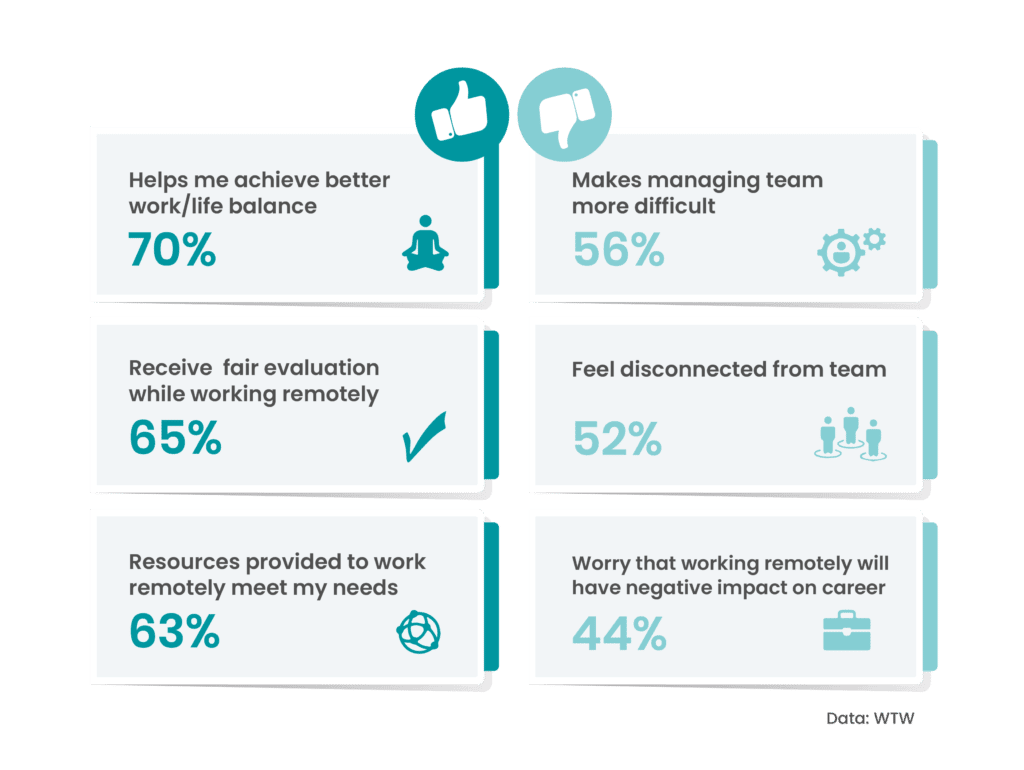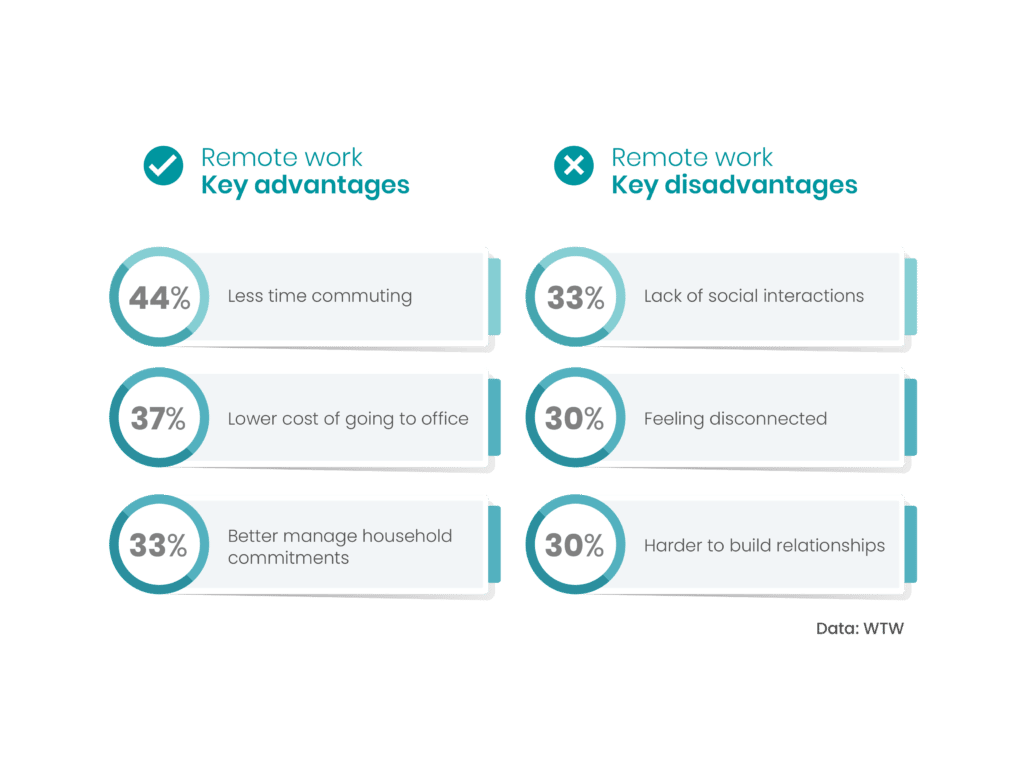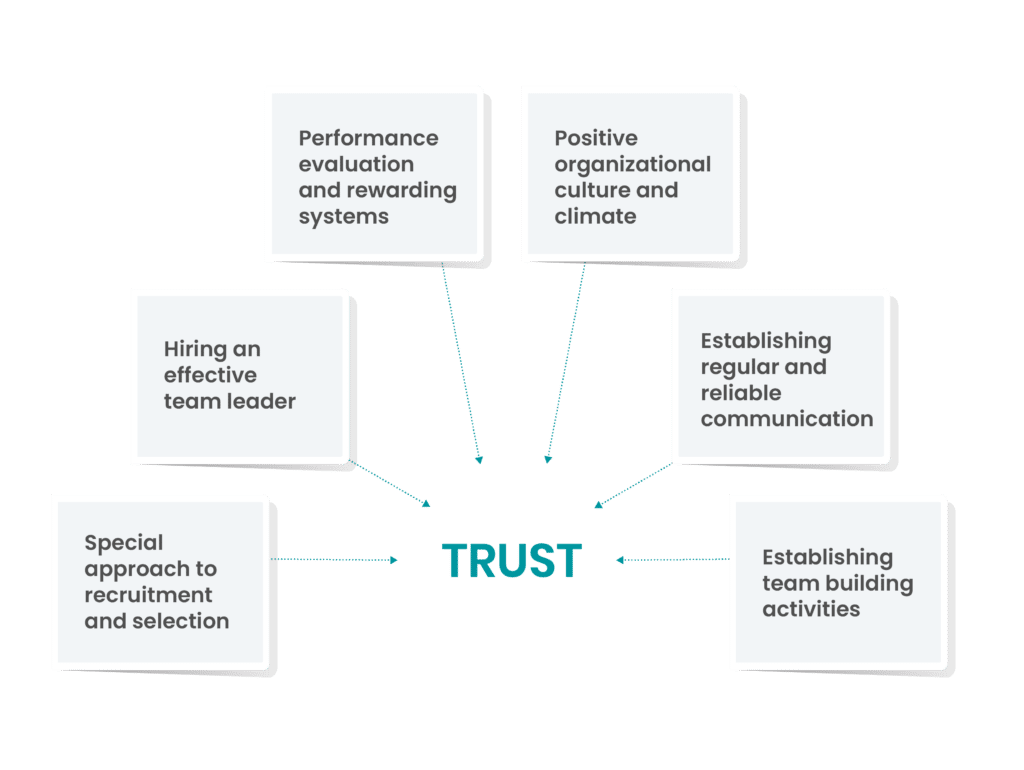A look at data and best practices for managing remote teams successfully
During the pandemic, the large majority of the global workforce was forced to work from home. Two things became apparent: remote teams were able to work together, create, supply and service other cities, countries and continents. It also became apparent that isolation, loneliness and mental health concerns were on the rise.
The learnings after three years of the pandemic need to now be taken into account when setting up new remote teams or continuing a remote work model.
Contents
Remote Work Advantages and Disadvantages at a Glance
Data shows that remote work has largely been a mixed experience for employees. Using both employee surveys and the available global data, changes can be targeted towards company-specific problems and implemented to support individuals in remote teams in ways that make a difference. If your company struggles to identify areas to improve, this overview offers key areas to focus on when managing remote teams.

Managing Remote Teams
More companies than ever are looking for ways to implement remote work or hybrid models as the new standard and are looking for best practices for managing remote teams. Implementing the best practices for managing remote teams is as important as being aware of key disadvantages of remote work.

To set your remote team up for success, the following topics are part of the best practices for managing remote teams:
Onboarding New Teammembers in a Remote Team:
Have a plan: what should be accomplished in the first week, month or six months? How can you and the team ensure the new employee will get there? Key aspects and ideas to consider to make onboarding for remote teams a success are:
- Regular check-ins: more frequent than in in-person scenarios
- Find an onboarding partner the new employee can reach out to
- Empower collaboration and include new employees from the start
- Set up or add new employees to conversation spaces from well-being to productivity and “coffee breaks” or after work club for book club, game night or others that fit your company culture

Remote Team Communication and Productivity:
From video conferencing and project tracking to file sharing and chat, having a set of tools and software that works for your remote employees, managers and your entire organization is key. If it’s established already, ensure it still ticks all the boxes by adding questions about it into employee surveys.
- Upskill employees and new hires in tools and software crucial to your organization
- Communication is key: start the day with a morning meeting
- Set up structures that allow for easy collaboration and exchange

Trust in Remote Teams:
When your teams work remotely, having them sign in and sign out of their communication channels doesn’t necessarily translate to productivity. One of the key advantages of remote work is the work-life-flexibility that employees gain.This only works when employees are able to trust coworkers and managers. This leads to more productivity, less stress and overall job satisfaction.
- Measure the results, not the hours
- Offer flexible working hours, especially when working across timezones
- Be transparent, it builds trust
- Be accountable and expect accountability from each team member
- Set clear expectations, possibly through a project management tool, for meeting objectives, goals and deadlines
- Recognize achievements

Employee listening for Remote Teams:
A key part of a positive remote employee experience is employee listening. This is how you capture and understand the employee experience – when leading remote teams, employee listening shows what works and what needs to be improved.
- Set up regular 1:1 check-ins that are more frequent than in office settings
- Send out engagement surveys regularly, especially after implementing something new – this could be targeted at certain teams
- What works, what doesn’t? Ask for and learn from company-wide employee feedback
Nurture Remote Team Work Culture:
Establishing a remote workplace culture that supports remote employees is key.
- Hold regular team meetings for your remote workforce
- Keep a “Watercooler”channel where people can drop in at a set time without a set topic to discuss
- Support and offer employee wellbeing
- Let employees present completed projects to the company, so they own their area of expertise and other team members or other remote teams get to know them and their skill set better
- Implement virtual town halls, project celebrations and at least one annual in-person meet-up
Best Practices for Managing Remote Teams: Teambuilding
A big part of company culture are community and connection. These are achieved through teambuilding, which often comes naturally in office settings. With a dedicated and intentional approach, the same can be achieved through activities that are part of the team building best practices for remote teams.
- When a new employee joins: My User Manual – share your personal remote work style so people get to know you a little
- Start of the week: Rose & Thorn – share something positive for the week (rose) and a challenge (thorn)
- Regularly: virtual lunches – relaxed chats over a bite to eat, what’s not to love
- Fun break: mini games like Kahoot or remote work bingo
- Channels: playlists, holiday destinations, workouts, and many more
How to Optimize Your Remote Work Setup as an Employee
Working with remote teams has a lot of advantages for work-life flexibility. However, being productive and successful in a remote work setup starts with the right mindset, the right tools and a dedicated workspace.
Before you start your remote job, do your part: ensure that you are set up in the best possible way to join a remote team. These ideas can also be used by companies as part of their onboarding plan:
- Create a dedicated workspace, ideally in a separate room
- Get ready in the morning like you would if you went to an office: shower, eat breakfast and get dressed
- If you’ve commuted before, use the time that is freed up through remote work for a so-called “decompression” activity: whether its exercise, reading, mindfulness or a walk can help separate work from life in a remote workspace
- Ensure you are set up for video calls and file sharing – check your internet speed and get comfortable, quality headphones
Key Search Executive Search: A Fully Remote Team
At Key Search, we see the many benefits of a virtual team in our work efficiency, work-life-balance, job mobility and work-life-flexibility. We also see many of our clients move towards a hybrid or full remote set-up to be able to hire globally in a tight labor market.


